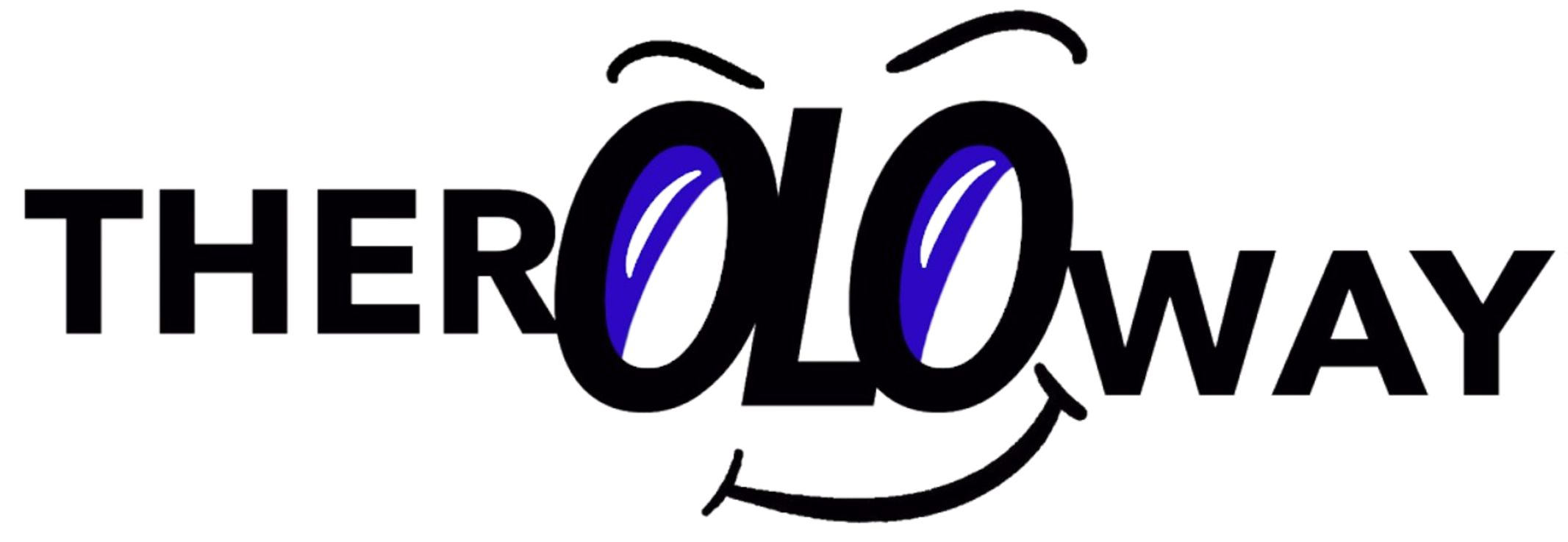Annie Jump Cannon and the Unseen Riddle of the Little Red Dots
1 | - “This Looked Easy Yesterday”
Harvard Plate Vault (1901) ⇄ JWST Mission Ops (2023)
The Morning Routine
Annie Jump Cannon settles into her bench in the chilly vault, lamp hissing behind frosted glass. The day’s work is simple in theory, just sort last night’s Harvard plates by the darkness of their hydrogen absorption lines. She hums "Oh Be A Fine Girl Kiss Me"… while penciling A0, F5, M2—the seven‑letter ladder she has just wrestled out of a tangle of earlier schemes. By noon she will clock a few hundred stars, on her way to a lifetime tally of ≈350,000 spectra. The cadence feels mechanical, but every classification tightens a map of the Milky Way that did not exist the day before.
Rolo's Note: Balmer lines are dark stripes where hydrogen soaks up starlight, their depth tracks temperature the way grill marks track heat. And fun-fact: "Oh Be A Fine Girl Kiss Me" was a song she enjoyed and the letter's would become the official mnemonic for star brightness classification - see Stellar Map.
An Uneasy Sky
Across a century—and 1.5 million km of vacuum—the james webb space telescope mirror hangs golden over its sunshield, 18 hexagons acting as a single 6.5‑metre eye tuned to infrared. On 8 August 2023, in data from the Cosmic Evolution Early Release Science (CEERS) field, engineers notice a pixel‑scale smudge so red it almost falls off the detector. Photometric fit: redshift z ≈ 8.3; apparent size: a few hundred light‑years, working nickname scribbled on the ops whiteboard: “LRD‑1”—the first of what observers will soon call little red dots.
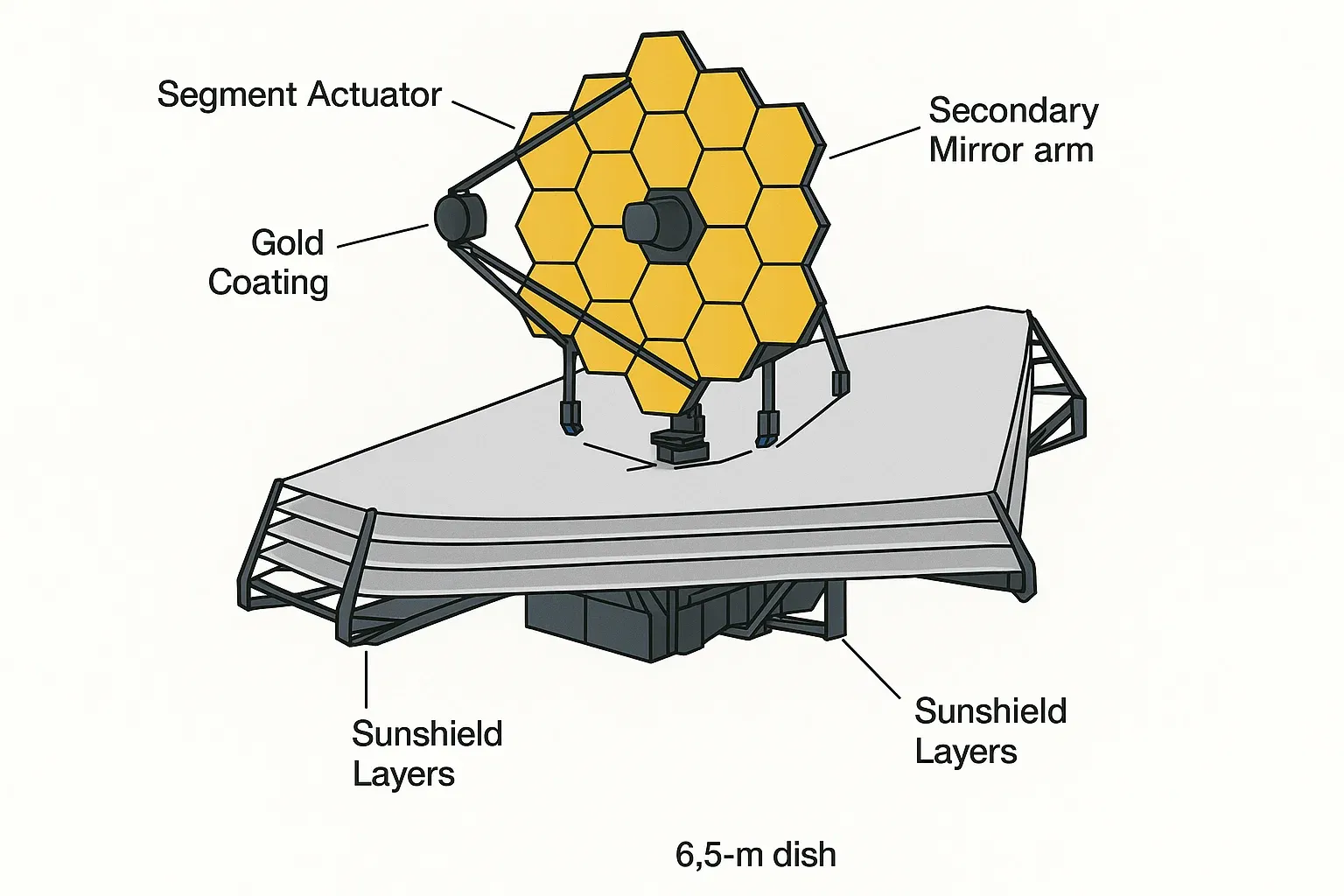
Rolo's Note: a redshift of 8 means the light left its source ~650 million years after the Big Bang, JWST sees it because its instruments live in the mid‑infrared, where those ancient photons have drifted. You can better understand how this powerful telescope works here.
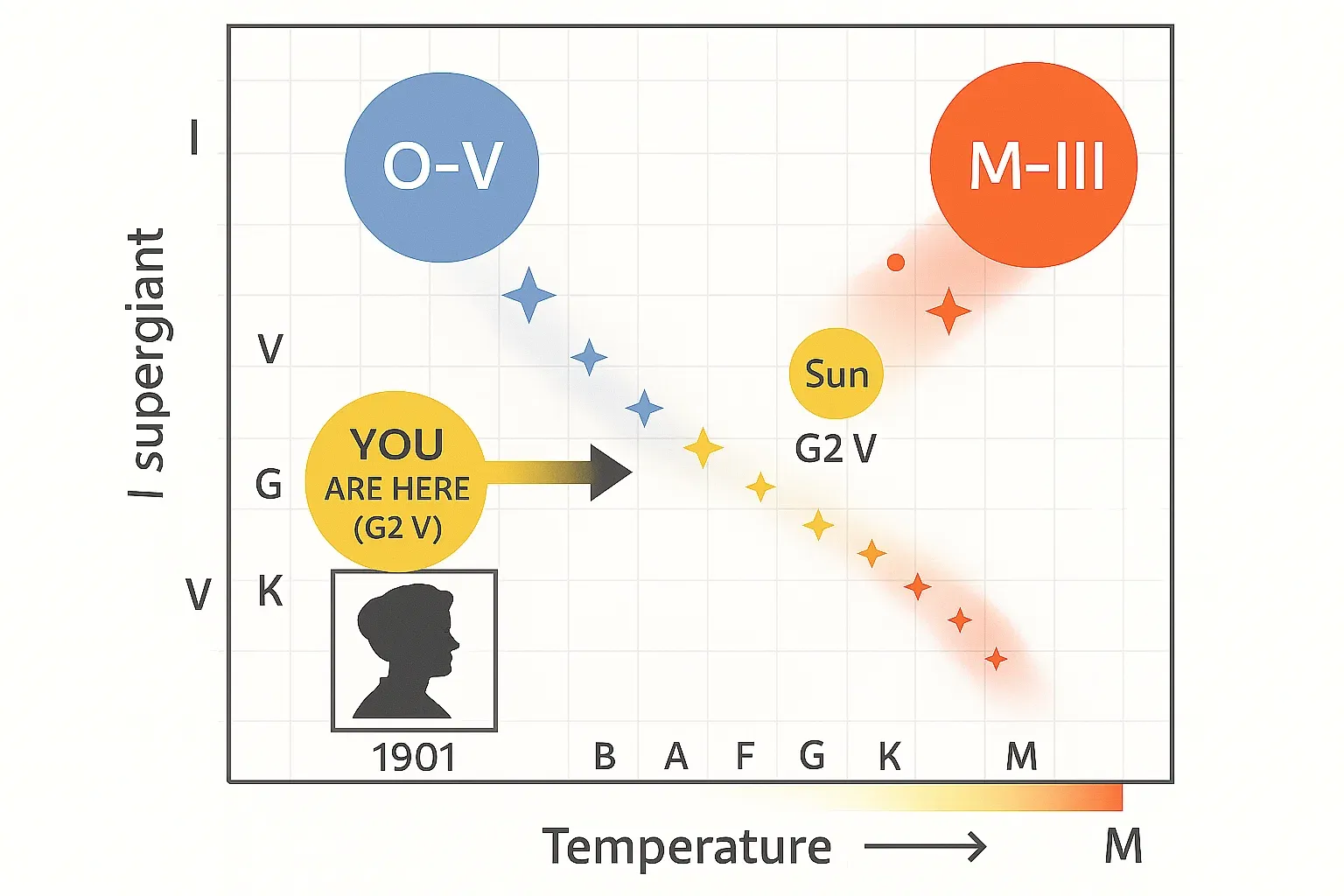
The Inciting Question and A Glance Backward
The spectrum arrives two weeks later. Instead of tidy absorption bars, it shows a broad H‑α emission hump smeared over thousands of km/s, plus a jagged “V” around the Balmer break—signals that usually flag gas feeding a black hole. But the object is too faint for a classical quasar and eerily silent in archival X‑ray maps. The ops team stares; someone mutters that everything they know about early galaxies just twitched.
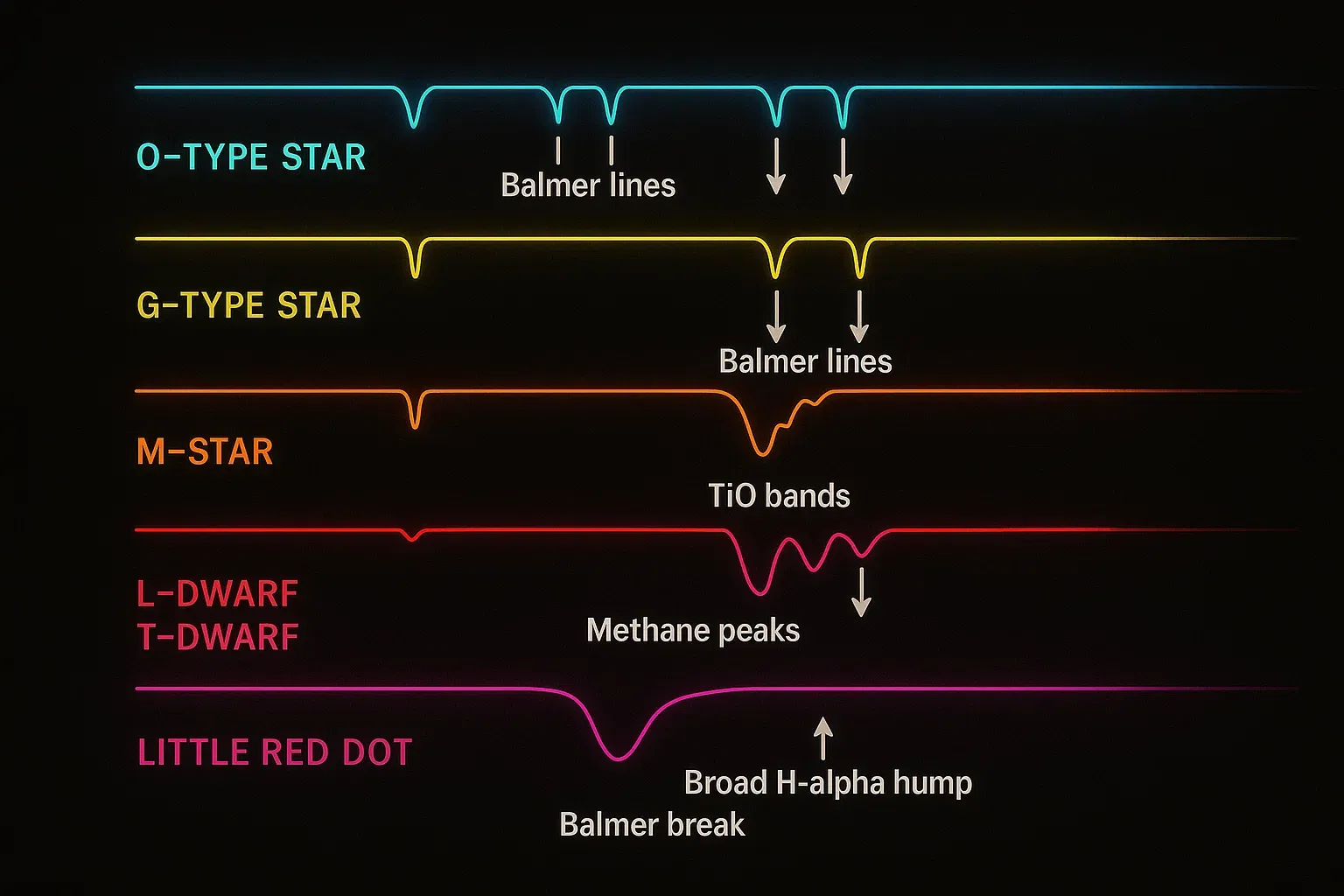
Cannon once faced her own glitch. The Harvard ladder placed both red giants and red dwarfs in the M bin—same surface temperature, utterly different luminosity. Astronomers spent decades mis‑gauging distances until the Morgan–Keenan luminosity classes (Roman numerals I–V) supplied a second axis in 1943. Classification errors are not footnotes; they bend the geometry of the universe.
|
1901 Problem |
2023 Problem |
|
Giant vs. dwarf degenerate in “M” |
Starburst? AGN? Something new in
“LRD” |
Rising Stakes
JWST images soon uncover over 200 LRDs across CEERS, JADES, and NGDEEP surveys, all between redshift 5 and 9 and all smaller than a dwarf galaxy’s nucleus. If each were a normal star cluster, they would imply implausibly rapid galaxy growth, if each were a black hole, they would rewrite seeding models. Telescope‑time proposals pile up like storm clouds.
Theories in the Tall Grass
‒ Mini‑Quasar: a nascent super‑massive black hole gulping gas. Brightness fits; missing X‑rays don’t.
‒ Population III Super‑Star: a million‑solar‑mass hydrogen colossus; rare physics, but matches the spectral “V.”
‒ Tidal‑Disruption Flare: a mid‑mass black hole shredding stars; lines fit, lifetime short.
Each hypothesis moves a budget line. Call it a quasar and Chandra time gets requested, call it a super‑star and theoretical hydrodynamics teams spin up.
Cannon solved her mismatch by adding information—first decimals (G2 vs G5), later luminosity tags (III vs V). Modern astronomers eye similar fixes: maybe a dust‑obscuration scale, maybe a “compactness index,” maybe a brand‑new spectral letter appended beyond Y. The grammar of the sky keeps stretching.
Rolo's Note: dust absorbs blue light and re‑emits infrared; a cocooned black hole can thus glow red while hiding its high‑energy X‑rays.
The Turn
On 12 October 2023, a deep JWST/NIRSpec exposure of LRD‑17 reveals not just broad H‑α but also a weak [O III] wing and a blueshifted absorption trough—evidence of an outflow ≥ 1,000 km/s (A&A). Outflows are black‑hole signatures; the “star cluster” option limps. The find echoes Cannon’s personal turning point: the day she saw helium lines in an O‑star spectrum and realized temperature trumps brightness. Here, gas kinematics trump color.
Mission Ops updates the priority list: every red speck with a certain infrared slope now queues for spectroscopy. Scientists nickname the program “Red Grass,” a nod to the silent fields where Prey’s Comanche hunter first senses an alien predator. The metaphor sticks because the danger, again, is invisible until you learn what to look for.
A Larger Hunt
By year’s end, the working model is “obscured faint AGN”: black holes of 10⁷–10⁸ M⊙ embedded in seed galaxies, their X‑rays muffled by dense gas. It's not final, but it explains the numbers without breaking ΛCDM. The field exhales—then inhales again, because every solved riddle in astronomy usually spawns two new observing campaigns.
Cannon would recognize the rhythm. Label, revise, repeat. Her glass plates and JWST’s gold hexagons chase the same quarry—the cosmic order that won’t sit still. The next sections will follow the hunt through expanded taxonomies and the hard choices they force, but the opening question endures: when the pattern breaks, how brave will we be about changing the alphabet?
2 | - Tracks in the Grass
Yerkes Observatory (1943) ⇄ JWST Analysis Suite (2024)
The First Mis‑step
In the spring of 1943, William Morgan pins a new chart beside Annie Jump Cannon’s seven letters. A diagonal smear of data points has been haunting researchers: stars that share Cannon’s “M” temperature but blaze a thousand times brighter than their kin. Morgan’s solution is brutally simple—add a verticallabel. Hence the Morgan–Keenan luminosity classes: I for supergiants, V for dwarfs, with II–IV in between. Two coordinates—temperature and luminosity—snap the Hertzsprung‑Russell diagram into sharp focus, and red giants finally part company with red dwarfs. “Classification must match physics,” Morgan tells a graduate assistant, “or the sky lies to us.” Astrophysics Data SystemWikipedia
Rolo's Note: wider spectral lines mean higher gas pressure, giants have low pressure, dwarfs high, so line width becomes a size clue.
A 21st‑Century callback
Eighty years later, JWST scientists replay the scene in reverse. Their compact crimson specks—Little Red Dots—refuse any known label, even with a dozen observed parameters. A second axis isn’t enough, and the puzzle calls for a new dimension altogether. Obscuration, compactness, perhaps black‑hole dominance. The team’s whiteboard looks like Morgan’s, only the axes read infrared slope and Balmer‑break depth.
Tool Upgrade
In the decades between, astronomers stretched Cannon’s ladder by tacking on fresh letters. Brown‑dwarf hunters found objects cooler than M‑stars and coined “L” in 1997, “T” in 2000, then “Y” in 2011 when WISE netted an object barely room‑temperatureAstrophysics Data System. Each step followed Cannon’s playbook: spot odd spectra, assign a placeholder, decode physics later.
|
Old Alphabet |
Year Added |
Driver |
|
L |
1997 |
Infrared surveys found dusty,
1 300–2 000 K dwarfs |
|
T |
2000 |
Methane‑rich spectra below 1 300 K |
|
Y |
2011 |
WISE discovered ~300 K objects with
ammonia lines |
Rolo's Note: the L–T–Y chain lives entirely in infrared; they’d be invisible on Cannon’s blue‑sensitive plates.
The Mirror’s Purpose
All these late‑alphabet creatures proved the wisdom of building an infrared giant. “The James Webb Space Telescope is designed primarily to observe faint, red‑shifted light from the first stars and galaxies,” brags a NASA brief pinned above the mission console. Its 6.5‑metre mirror is overkill for most local stars—but perfect for compact red enigmas 13 billion light‑years away.
Counting the Dots
By March 2024, survey teams list ≈240 LRDs spanning redshift 5 – 9 across CEERS, JADES, and NGDEEP fields, with effective radii often <300 light‑years. That abundance is ten times forecasts for normal dwarf galaxies at the same epoch. Either our galaxy‑formation models need triage, or most “dots” aren’t galaxies in the usual sense.
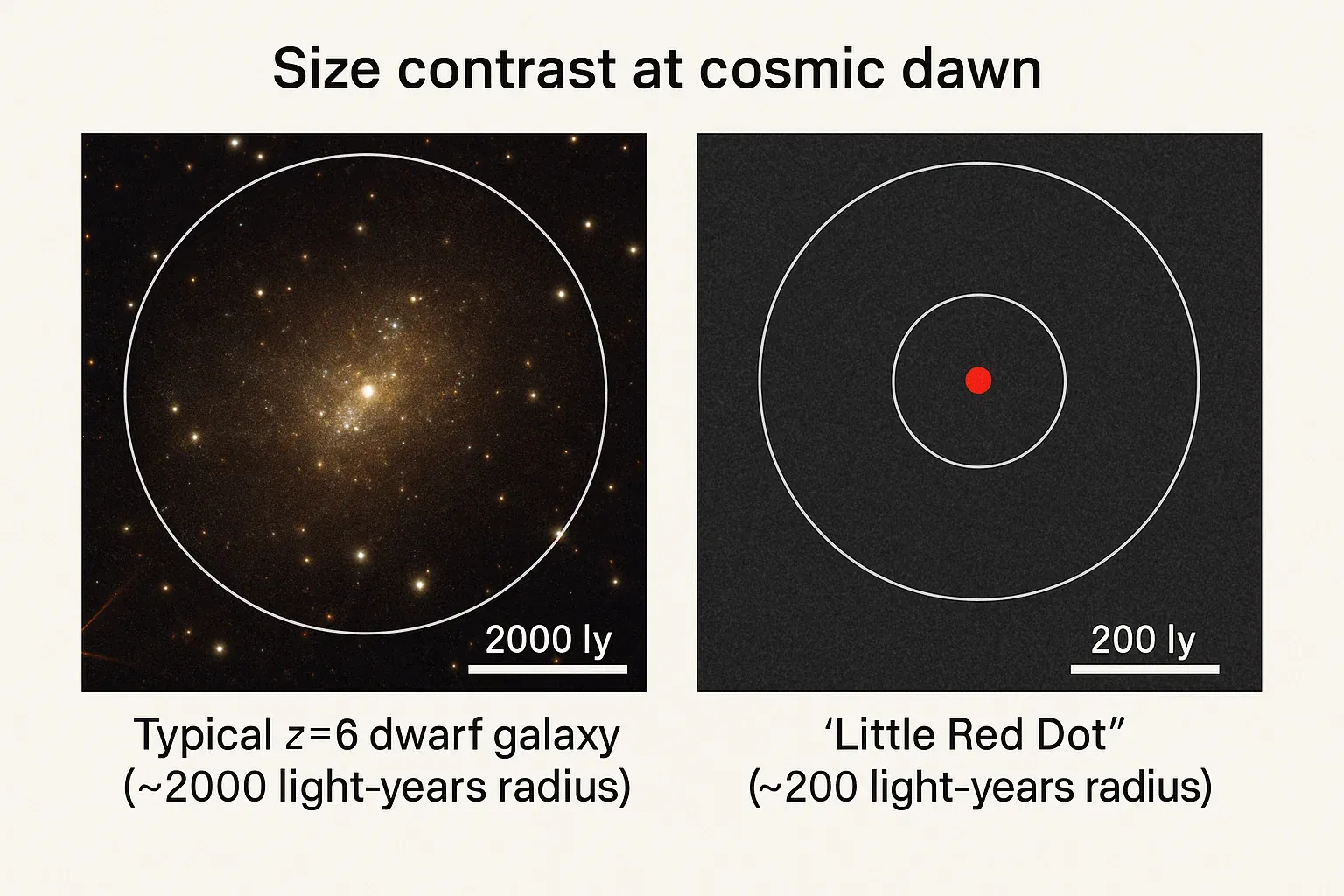
A Spectral Ambush
A deep NIRSpec stare at LRD‑87 exposes broad H‑α (FWHM ≈ 2 800 km s⁻¹) and a faint, blueshifted [O III] wing—classic outflow markers of an active galactic nucleus. Yet Chandra and XMM stacks show no matching X‑ray spike. The contradiction triggers the same dread Morgan felt when giants violated distance ladders: the instrumentation says two conflicting things at once.
False Trails
Teams float three contending scripts:
- Dust‑cocooned mini‑quasars—X‑rays smothered by Compton‑thick gas.
- Super‑massive Population III stars—ephemeral titans gone within a million years.
- Tidal‑disruption flashes—intermediate‑mass black holes snacking on dense clusters.
Each path demands fresh observing time. Funding boards hesitate, demanding a “best‑fit” story before approving million‑dollar pointings. Classification, again, steers the purse.
Learning from Annie
Cannon’s archival notes (plate JD‑1423, margin: “giant?”) remind us that uncertainty is actionable. She refined her scheme by writing maybe with a question mark, then gathering more plates. Modern researchers mimic that humility with probability matrices: every LRD now carries a likelihood tag—AGN 80%, Pop III 15%, TDE 5%. The universe rarely offers 100 percent lines.
Rolo's Note: probability tags come from Bayesian fits to spectral energy distributions; the broad‑line width and infrared excess weigh heavily toward AGN.
Midpoint Victory—But at a Cost
A June 2024 multi‑wavelength campaign nails seven LRDs with faint Fe K‑α X‑ray lines after 200 ks of exposure. The detections are weak but decisive: at least some dots house accreting black holes. Crisis averted? Not entirely—the implied black‑hole‑to‑stellar‑mass ratios run 5–30 percent, grotesquely higher than the Milky Way’s 0.1 percent norm. The model bends; it doesn’t snap.
The Alphabet Stretches Again
Discussion turns pragmatic: should LRDs earn a formal label—say, “Class Z AGN”? A draft memo echoes 1943’s Yerkes rationale: “A new class is justified when physical drivers differ and when detection tech makes identification routine.” On Slack, a post‑doc jokes they’re really “M‑for‑mystery” galaxies, but the name won’t stick; the field prefers letters in order.
As dusk settles over Yerkes’ old domes, a historian notes that every spectral revolution began with a mismatch: red giants, brown dwarfs, now LRDs. The pattern is almost comforting. Taxonomies evolve like ecosystems—disturbance triggers diversification. Section 3 will chase that evolution forward, asking how a 20th‑century ladder can keep steady footing on a 21st‑century slope. For now, the mirror that sees deepest, and the alphabet that keeps growing, are locked in an uneasy waltz—each daring the other to stretch first.
3 | - The Last Shot, the Wider Horizon
Royal Astronomical Society Council (2025) ⇄ Back to the Harvard Plate Vault
The Showdown Room
May 2025, London. Thirty people pack a walnut‑panelled salon at Burlington House; the agenda reads “Formal Recognition of Compact Red AGN Population.” New spectra, X‑ray stacks, and radio limits litter the table. One slide projects the tally: 312 little red dots (LRDs) confirmed between redshift 5 and 9, 76 percent showing at least one broad emission line, 18 percent now faintly detected in hard X‑rays after 300 ks co‑adds. Somebody quips that “we’ve met the enemy and it is dust.”
Rolo's Note: hard X‑rays penetrate heavier obscuration than soft X‑rays; a weak hard signal means the black hole is wrapped but not suffocated.)
The Vote Before the Vote
Delegates argue nouns. Are these “Type‑II mini‑quasars,” “Proto‑Quasars,” or something brand new? A post‑doc passes round a two‑page brief titled “Class C Galaxies”—C for Compact, Cocooned, and likely Controlled by a central black hole. The label nods to Annie Jump cannon, whose initial “C” once marked a provisional hydrogen‑line class before she scrapped it for clarity. History wiggles the same loose tooth.
The Spectral Trap Re‑Springs
Physicist Priya Sharma presents JWST/NIRCam grism data for LRD‑204. The Balmer break is deep, but the continuum is flatter than any starburst template. She overlays an SED model with A_V ≈ 6 mag of dust—fits perfectly. The room sees it: what looked like a too‑massive, too‑early galaxy is mostly a buried AGN glowing through a red veil. A century earlier, Cannon mistook some narrow‑lined M‑stars for giants until luminosity gave them away; here, luminosity masquerades as stellar mass until dust is subtracted.
A Third Axis Drawn in Chalk
A historian of science sketches a cube: Temperature (Cannon’s axis) runs left–right, Luminosity (Morgan–Keenan) climbs vertical, and a new depth axis labelled “Obscuration / Compactness” points into the board. The proposal: locate every high‑redshift source inside this 3‑D grid; LRDs occupy one extreme corner—cool‑looking because of dust, but intrinsically hot and luminous. The cube is unofficial, but the idea of a three‑coordinate taxonomy lands.
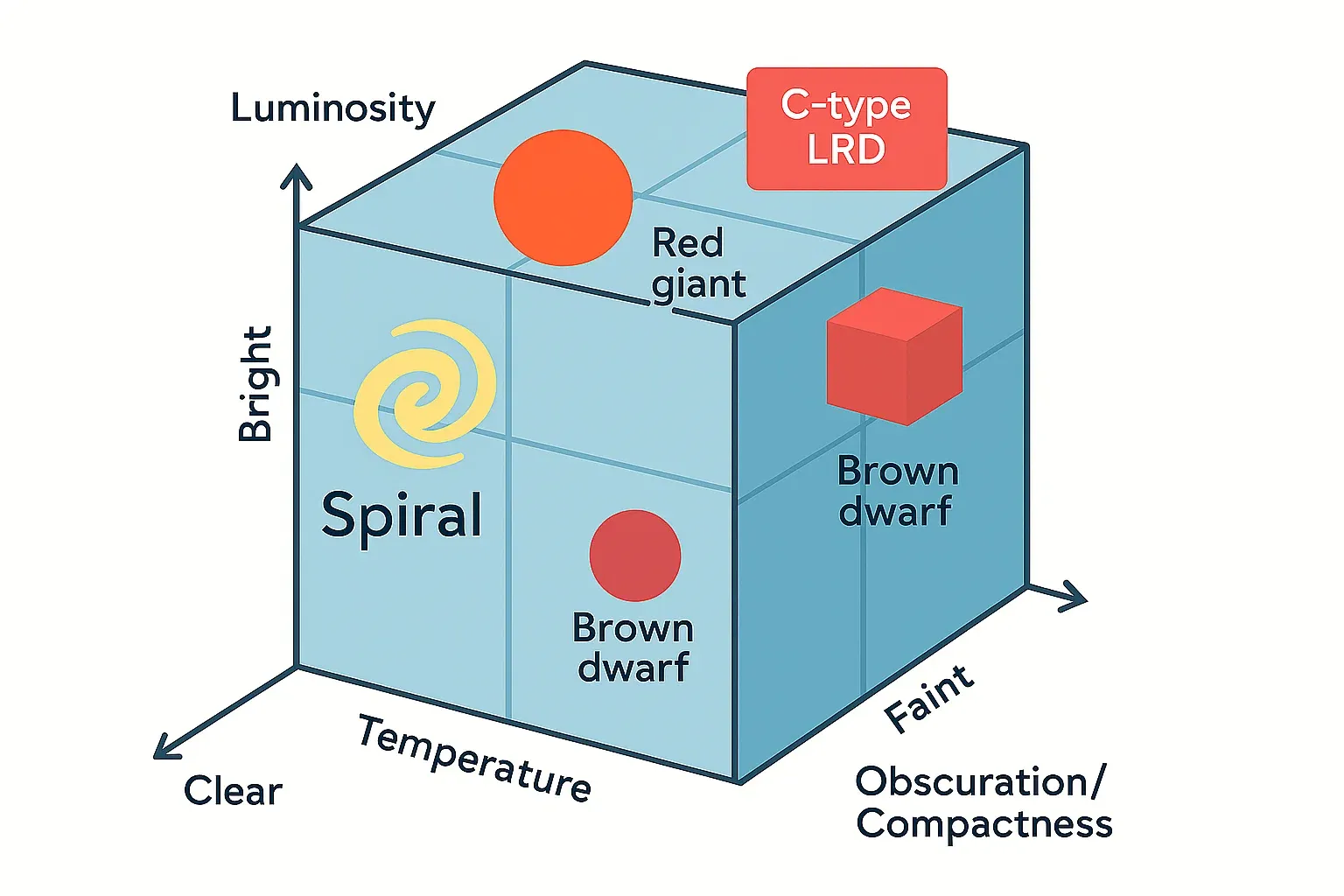
| Axis | 1901 Status | 1943 Status | 2025 Extension |
|---|---|---|---|
| Temperature (O–M) | Defined | Refined | Holds |
| Luminosity (I–V) | — | Defined | Holds |
| Obscuration/Compactness | — | — | Proposed |
Flashback to the Vault
A slide dissolves to a sepia photo, Cannon at her desk, stacks of plates like dominoes. Her handwritten margin note on plate JD‑1423—“giant?”—is highlighted. The delegate points out that Cannon never hesitated to mark uncertainty in ink. The lesson is that ambiguity is data.
The Telescope Insider’s Whisper
Engineer Gabriela Ortiz reminds the council that the James Webb Space telescope mirror can’t linger forever, micrometeoroid pitting has already nudged one segment out of spec. A next‑gen infrared flagship (concept name LUVOIR‑B) is a decade away. If taxonomy remains fuzzy, new proposals will falter. “We need a target list with names that grab reviewers,” she says—half joke, half survival instinct.
Decision Moment—The Climax Beat
After lunch, Chair Alan Zhang calls for a straw poll: adopt “C‑type compact red AGN” as a provisional class, yes or no. Twenty‑three hands rise in favor. It’s not the IAU, but it is momentum: a formal bucket that will appear in telescope time requests, simulation keywords, and arXiv titles. The vote passes; relief mingles with the thrill of naming. Classification, like a hunter’s final arrow, finds its mark.
One month later, software engineers patch the open‑source spectral‑fitting tool Bagpipes to include a C‑type template: a reddened power‑law continuum plus narrow [O III] wings and optional weak Fe K‑α. Machine‑learning projects retrain on the new library. No algorithm is christened “The Cannon 2.0”—the community remembers that Cannon herself cautioned against ego in labels—but her spirit lingers in every fit_status = uncertain flag the code now outputs.
Rolo's Note: Bagpipes is an SED‑fitting code that models galaxy light with stellar and AGN components.
What Changes on the Ground
Within six months, proposals referencing C‑type targets secure 20 percent more JWST Cycle 3 time than generic “high‑z red object” proposals. Simulations from three groups show that embedding early black holes in dust‑rich halos reproduces both the LRD counts and their strange X‑ray faintness, closing a gap in ΛCDM without exotic physics. Theory, observation, and funding finally rhyme.
A final slide returns to Cannon’s ladder—OBAFGKM printed bold. Under it, small type reads: “Classification is a promise that the next discovery will fit, or else the ladder will grow.” The council adjourns. Outside, drizzle darkens the courtyard. One historian pockets a copy of the vote tally and thinks about that first graphite “A0.” Across a century, from glass plate to gold mirror, the work has not changed - see the unknown, name it carefully, and be ready to rename it.
This, in it's entirety is a sign that the field is willing to redraw its maps. Cannon would smile—then reach for another plate.
